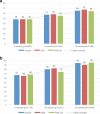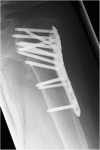Locking nail versus locking plate for proximal humeral fracture fixation in an elderly population: a prospective randomised controlled trial
- PMID: 30630465
- PMCID: PMC6329164
- DOI: 10.1186/s12891-019-2399-1
Locking nail versus locking plate for proximal humeral fracture fixation in an elderly population: a prospective randomised controlled trial
Abstract
Background: Proximal humeral fractures (PHFs) are the third most common fracture in older patients. The purpose of the study was to prospectively evaluate the outcomes of PHF fixation with a locking blade nail (LBN) or locking plate (PHILOS) osteosynthesis in a homogeneous elderly patient population.
Methods: Inclusion criteria were an age > 60 years and the capacity to give informed consent. Patients with isolated tuberosity fractures, previous trauma or surgery, advanced osteoarthritis, fracture dislocation, pathological fractures, open fractures, neurological disorders, full-thickness rotator cuff tears, fracture line at the nail entry point or severely reduced bone quality intra-operatively were excluded. Eighty one patients with PHFs were randomised to treatment using LBN or PHILOS. Outcome measures comprised Constant score, age and gender adjusted Constant score, DASH score, VAS for pain, subjective overall condition of the shoulder (1-6) and active shoulder range-of-motion in flexion and abduction. Plain radiographs were obtained in two planes. All data were collected by an independent observer at 3, 6 and 12 months postoperatively.
Results: Thirteen patients were excluded intra-operatively due to rotator cuff tears, fracture morphology or poor bone-quality. Of the remaining 68 patients, 27 in the LBN and 28 in the PHILOS group completed the full follow-up. Mean age at surgery was 75.6 years and the majority of PHFs were three-part fractures (49 patients). Baseline demographics between groups were comparable. All outcome measures improved between assessments (p < 0.001). The LBN group showed improved DASH scores as compared to PHILOS at 12 months (p = 0.042) with fewer incidences of secondary loss of reduction and screw cut-out (p = 0.039). A total of 29 complications (in 23 patients) were recorded, 13 complications (in 12 patients) in the LBN group and 16 complications (in 11 patients) in the PHILOS group (p = 0.941). No significant inter-group difference was observed for any other outcome measures, nor was fracture morphology seen to be associated with clinical outcome or complication rate.
Conclusions: At short-term follow-up, LBN osteosynthesis yielded similar outcomes and complication rates to PHILOS plate fracture fixation in an elderly patient population, though with a significantly lower rate of secondary loss of reduction and screw cut-out.
Registration trial: No. DRKS00015245 at Deutsches Register Klinischer Studien, registered: 22.08.2018, retrospectively registered.
Keywords: Geriatric traumatology; Locking proximal humeral nail; Locking proximal humeral plate; Proximal humeral fracture.
Conflict of interest statement
Ethics approval and consent to participate
The study was performed in accordance with the Declaration of Helsinki and the study protocol was approved by the local ethics committee (Ludwig Maximilian University Munich) before initiation of this study (approval No. 442–13). All patients provided written informed consent to participation.
Consent for publication
Not applicable.
Competing interests
The first author (J.E.P.) has participated in a shoulder fellowship program that was sponsored by DePuy Synthes Mitek. The senior author (E.M.) is a consultant and receives royalties from Marquardt Medizintechnik Europe. All other authors declare that they have no competing interests.
Publisher’s Note
Springer Nature remains neutral with regard to jurisdictional claims in published maps and institutional affiliations.
Figures







References
-
- Gracitelli MEC, Malavolta EA, Assunção JH, Kojima KE, dos PR R, Silva JS, et al. locking intramedullary nails compared with locking plates for two- and three-part proximal humeral surgical neck fractures: a randomized controlled trial. J Shoulder Elb Surg. 2016;25:695–703. doi: 10.1016/j.jse.2016.02.003. - DOI - PubMed
Publication types
MeSH terms
LinkOut - more resources
Full Text Sources
Medical

